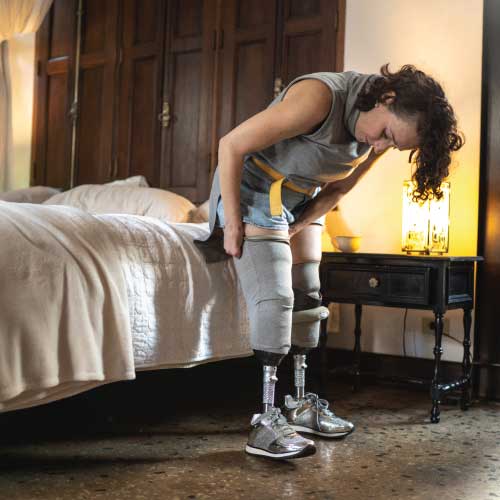Above-Knee Amputees May Benefit From This Experimental Exoskeleton
Above-knee amputation is known to reduce mobility and quality of life severely. This is mainly because the surgery removes much of the leg’s muscles. To help solve this problem, engineers at the University of Utah’s Bionic Engineering Lab created a new experimental exoskeleton that could make moving and walking more manageable for many individuals with above-knee limb loss.

According to the researchers, a standard prosthetic leg for above-knee amputees can’t completely replicate the biomechanical functions of a biological leg. Because of this limitation, people with above-knee limb loss overexert the muscles in their residual and intact limbs to counterbalance the lack of energy from the prosthetic leg.
The research team’s goal in creating the experimental exoskeleton is to provide users with extra energy so walking can feel natural again. The device is designed to wrap around the user’s waist and residual limb. It uses embedded microprocessors and battery-powered electric motors to enable an above-knee amputee to walk with much less effort than a conventional prosthetic leg.
The researchers also designed the exoskeleton to be lightweight. It also features an electromechanical actuator attached to the user’s thigh on the residual limb to convert electrical energy to mechanical energy. The harness around the waist contains microcontrollers, sensors, and custom electronic systems that drive advanced control algorithms. The exoskeleton also has artificial intelligence, which learns how the user moves.
Unlike the exoskeleton suits typically used to lift heavy loads, this device gives the user just enough extra power for walking. Tommaso Lenzi, a mechanical engineering assistant professor and lead researcher, likens this function to an electric bike with a motor that assists the rider when pedaling the bike uphill.
Wearing the exoskeleton is like riding an electric bike with a motor that assists the rider when pedaling the bike uphill.
To test the device, the group tapped six individuals with above-knee limb loss. The participants were asked to walk on a treadmill with and without the exoskeleton while the researchers measured their carbon dioxide levels and oxygen intake. The study found that the participants who used the exoskeleton reduced their energy consumption by an average of 15.6%.
According to Lenzi, this improvement is equivalent to removing a 26-pound backpack. He also said they are “close to what an average person would expend at the same speed.”
With the exoskeleton, the participants reduced their energy consumption by 15.6%, which is equivalent to removing a 26-pound backpack.
Another critical factor is that the researchers designed the device to be lightweight. The frame is made of carbon-fiber material, while other parts are constructed of aluminum and plastic composites. The exoskeleton only weighs 5.4 pounds.
According to Lenzi, the exoskeleton could be available in a couple of years. However, there are some exercises you can do now to strengthen your body for prosthesis use.











































































